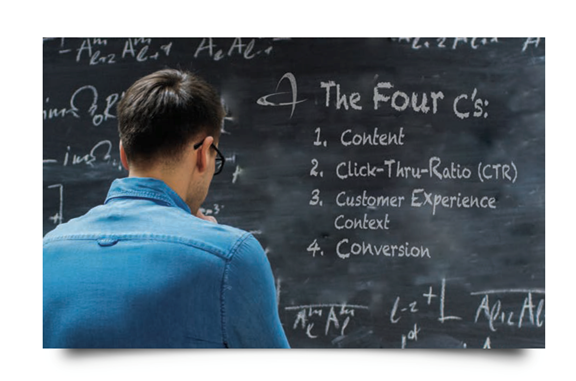Updated June 19, 2023
How to achieve mastery of the delicate & complex art of converting online customers with web content

In mapping a path to successful conversions, let’s begin with the four C’s, which goes something like this: Content drives the click-through ratio into a moment of inspired customer experience, leading to conversions.
In other words, interesting, engaging content translates to a good click-through ratio. And when you have engaged users in the context of their buying journey, that leads to higher conversion rates.
In my whitepaper, the Algorithm for Consumer Spending, I go into detail discussing how marketers should keep these core areas at the front of their minds when getting into comprehensive marketing strategies. Conversions are most effective, for instance, when the targeted consumers can connect an unmet need through what you offer. Once the targeting act is clear and effectively implemented, your content needs to frame-up your offering in an exact and compelling way. Think about what will motivate a potential conversion to cross the finish line. Can you make it easier for them? Can your brand messaging assuage any fears , friction, or uncertainty they might have around purchasing with you?
Here’s how to think about the path to a conversion. A brand that makes a strong value proposition from its target market and offers relevant, value-adding messaging will gain customers’ trust. Once trust is earned, it becomes possible to add a layer of legitimate incentive – especially if brands keep humans’ core needs at the center of their offering. In what follows, we’ll explore how conversions are facilitated through web pages, e-mail, and social sharing.
As digital marketers know, there is no conversion strategy without a conversion landing page. Arranging the page’s elements in a visually intuitive way will help hook a customer. Conversion pages also need to include a short headline that cuts to the chase and grabs a reader’s attention. The page’s copy should clarify what you’re offering and give details about its appeal. Build-in ways to gather data on your conversion page with analytics, form fields, or other interactive elements. Include an inspiring call to action, laid out in a way that helps customers feel good about hitting that submit button. Some A/B testing of your conversion landing page will reveal how successfully it connects with potential customers and how comfortable they feel while using it.
Once your site is up and running, it’s key to determine how many visitors it takes to make a sale – a figure that will be different for every business. Watch your analytics closely and consider this two-part equation. You can calculate the number of visits needed to secure a sale by dividing how many conversions you attain from your overall traffic. Then, divide sales from visits to see how many conversions actually add up to sales.
Many of the elements that inform conversion web page success also play a role in e-mail marketing. E-mails need to grab a customer’s attention through a smart, quick-to-read subject line and headline. Put your offer front and center in your introductory sentence. E-mails are best when kept brief – every word counts, and every word needs to be convincing. Always give your customer a call to action to smoothly proceed to the next step in the purchase journey. As much as you can, provide a tone of encouragement and affirmation to your customer.
Once your content exists across multiple channels, it’s worthwhile to consider the efficacy of your social media output. I cite Felix Salmon, whose viral velocity formula multiples your site strength by how shareable your content is in my whitepaper. This figure is again multiplied by the number of “friends” or followers you have, which is multiplied yet again by how catchy or click-baity your headline is. All of this is multiplied by the throttle component, or how probable it is that Facebook & other social media sites will end up surfacing the content shared in friends’ feeds.
To dive into this formula and the other formulae mentioned here, read the full whitepaper, The Algorithm for Consumer Spending.
This article is part of The Algorithm for Consumer Spending Series.

